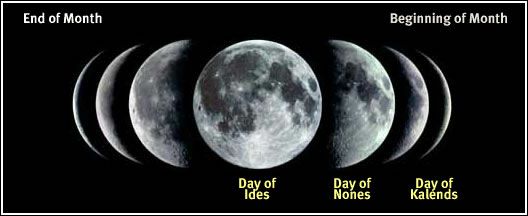Today is the Ides of March, and yes it is just any other Monday, but for some you need to be careful on this date.

The Ides of March the is the 74th Day in the Roman calendar otherwise known as the 15th of March.
Ides is dedicated to Jupiter and was the time of the full moon. The Roman calendar was based on the phases of the moon. Each month was the length of the lunar cycle and “ended on the day of one of the first three phases of the moon: new, first quarter or full. All days were referred to in terms of one of these three moon phase names, Kalends, Nones or Ides.” (http://www.webexhibits.org/calendars/calendar-roman.html)

Did you know?
The Ides of March was when Julius Caesar was assassinated in 44BC.
“Caesar was stabbed to death at a meeting of the Senate. As many as 60 conspirators, led by Brutus and Cassius, were involved. According to Plutarch,[19] a seer had warned that harm would come to Caesar no later than the Ides of March. On his way to the Theatre of Pompey, where he would be assassinated, Caesar passed the seer and joked, “The Ides of March come”, implying that the prophecy had not been fulfilled, to which the seer replied, “Aye, Caesar; but not gone.”[19] This meeting is famously dramatised in William Shakespeare’s play Julius Caesar when Caesar is warned by the soothsayer to “beware the Ides of March.”[20][21] The Roman biographer Suetonius[22] identifies the “seer” as a haruspex named Spurinna.” (https://en.wikipedia.org/wiki/Ides_of_March)

Full moon and Lunar Calendar
Also, the Ides of March is determined by the full moon and reflects the lunar origin of the Roman calendar. According to the earliest Roman calendar, the Ides of March would have been the first full moon of the new year.
“The ides were the 15th days of four months (Martius, or March; Maius, or May; Quintilis, or July; and October) in the ancient Roman lunar calendar; they were the 13th in all other months (originally, Aprilis, or April; Iunius, or June; Sextilis, or August; September; November; and December. Ianuarius, or January, and Februarius, or February, were added later).”

“The word ides comes from the Latin word idus, which is possibly derived from an Etruscan word meaning “to divide.” The ides were originally meant to mark the full Moon (the “halfway point” of a lunar month), but because the Roman calendar months and actual lunar months were of different lengths, they quickly got out of step. The ancient Romans considered the day after the calends (first of the month), nones (ninth day before the ides, inclusive), or ides of any month as unfavorable. These were called dies atri.” https://www.almanac.com/fact/ides-of-march-the-ides-of-march-holiday
The Romans eventual changed their lunar calendar to a solar calendar and added more months and this calendar had 365 days per year (just like we use now) compared to the 304 days per year with only ten months that the lunar calendar had.
Take care today
So be careful today. If you haven’t consulted your soothsayer for what is in your future. Tread carefully and make sure you are away from swords, knives or any pointy objects. You cannot be too careful, right?
Sign up for my Newsletter
This post has affiliate links
